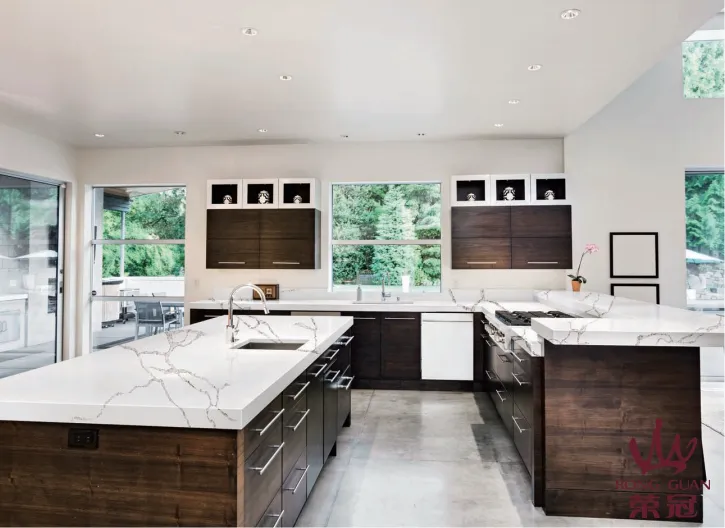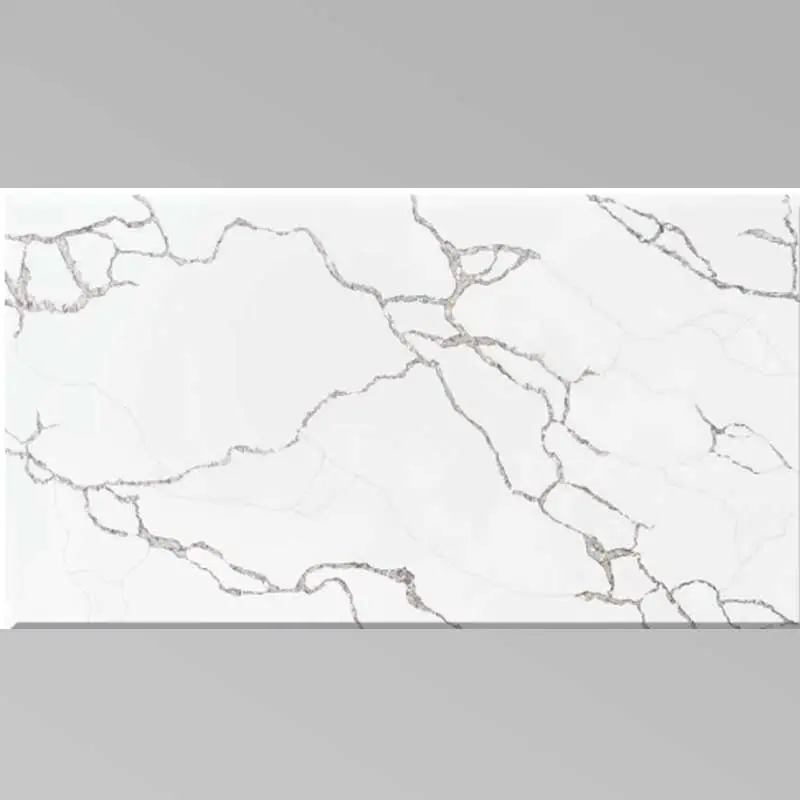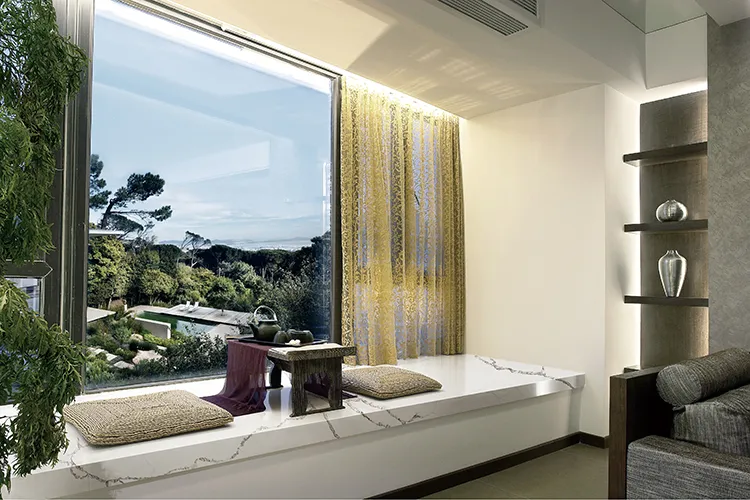Quartz kitchen countertops are not only beautiful and durable, but also favored by many consumers because of their high anti-fouling and anti-scratch performance. However, faced with quartz kitchen countertops of different thicknesses, consumers often ask a key question: Is the thicker the quartz countertop, the more expensive it is? Although intuitively, increased thickness means more materials and costs, the answer to this question is not simple. There are many factors that affect the price of quartz kitchen countertops, not just thickness.
This article will explore the relationship between the thickness and price of quartz countertops in depth from the aspects of materials, processing, installation, transportation, etc., to help consumers make wise choices when purchasing and installing quartz kitchen countertops.

What are the thicknesses of quartz kitchen countertops?
There are usually several common specifications for the thickness of quartz countertops, mainly including 2 cm (about 0.78 inches) and 3 cm (about 1.18 inches). In addition, some quartz manufacturers also provide 1.2 cm ultra-thin models and 1.5 cm medium-thick models. These thinner quartz kitchen countertops are mostly used in some special design occasions.
2 cm thick quartz kitchen countertop
The 2 cm thick quartz kitchen countertop is one of the more common choices on the market. It is lightweight and suitable for most home kitchens and bathrooms. Due to its moderate thickness, the 2 cm countertop is able to provide sturdiness and durability while maintaining a relatively low cost, so it is popular with consumers.
3 cm thick quartz kitchen countertop
The 3 cm thick quartz kitchen countertop is thicker than the 2 cm one, giving it a more high-end and stable visual effect. Quartz slabs of this thickness are usually used in high-end decoration or designs that require more sturdy support. Although the 3 cm quartz countertop performs better in sturdiness, its price is usually relatively high.
Ultra-thin quartz kitchen countertop
For consumers who want to pursue a modern and simple style in their design, some manufacturers offer ultra-thin quartz kitchen countertops of 1.2 cm or even 1 cm. This type of countertop is more refined in appearance, but requires additional support structures, especially under the countertop, to prevent the thin plate from cracking due to pressure.
Is the thicker the quartz countertop, the more expensive it is?
The main material of quartz kitchen countertops is a composite material made of natural quartz particles mixed with resin. Therefore, the amount of material used is one of the important factors affecting the price of countertops. In theory, the thicker the countertop, the more material is used, and the material cost will naturally increase. However, the increase in material cost is not completely linear, and the increase in thickness does not always push up the price in the same proportion.
Changes in material usage
A 3 cm quartz kitchen countertop is 50% thicker than a 2 cm quartz countertop, which means that more quartz particles and resin mixture are required per unit area. This increase in material directly affects the cost of the countertop, and in theory, it should make a 3 cm thick countertop more expensive than a 2 cm thick countertop. In particular, high-purity quartz materials are more expensive, and the increase in raw material demand caused by the increase in thickness will push up the product price.
Impact of material supply chain
The price of quartz kitchen countertops is also affected by the material supply chain. For example, the cost of mining, transporting and processing natural quartz ore directly affects the pricing of the final product. When the supply of quartz materials is tight, the price of a 3 cm countertop may increase significantly. On the contrary, in a market environment with sufficient supply, although the 3 cm quartz kitchen countertop uses more materials, its price may not be much more expensive than the 2 cm one due to production efficiency and supply chain optimization.

The influence of processing technology and thickness
Processing technology is also a key factor affecting the price of quartz countertop. Quartz countertops not only need to be cut, but also need to be edge processed, polished and other customized processes. Quartz kitchen countertops of different thicknesses face different difficulties and complexities during processing, which affects the final cost.
Cutting and forming
A 3 cm thick quartz kitchen countertop requires more time and stronger mechanical equipment during the cutting and forming process than a 2 cm thick countertop. Since quartz is a very hard material, cutting thicker quartz plates may require higher power cutting tools and more consumables, which directly increases the processing cost.
In addition, the customized processing of the countertop edge (such as beveled edges, rounded edges, waterfall edges, etc.) is also more complicated on 3 cm thick materials, and the cutting accuracy requirements are higher. This not only increases the processing time, but may also cause increased wear of the processing equipment, further increasing the processing cost.
Difficulty in processing thin plates
Compared with thick plates, the processing difficulty of ultra-thin kitchen countertops cannot be ignored. Due to their lower thickness, thin plates are more prone to cracking or damage during cutting and processing, requiring more delicate processes and higher precision. This means that although the material usage of thin plates is less, the cost will not be significantly reduced accordingly due to the increased difficulty in processing, and may even be similar to that of thicker countertops.
The relationship between installation cost and thickness
Installation is an important part of determining the final price of quartz countertops. Quartz kitchen countertops of different thicknesses have different requirements during the installation process, which also affects the cost of the entire project.
Difficulty in installing 3 cm countertops
A 3 cm thick quartz kitchen countertop is heavier and requires more manpower and more complex equipment to carry and fix during installation. Due to the increase in thickness, the weight of the quartz plate has increased by more than 50%, which requires installers to be more careful when operating to avoid damaging the wall or countertop.
In addition, although the sturdiness of 3 cm countertops is better, its heavy characteristics may place higher requirements on the cabinet or supporting structure during installation. Some designs may require additional reinforcement structures or special installation techniques to ensure the safety and stability of the countertop. These additional supports and reinforcements increase the cost of installation.
Installation complexity of thin countertops
Although ultra-thin kitchen countertops are lighter when transported, they require additional support structures during installation due to their thinness, especially in overhanging areas. These support structures may include plywood or steel frames to ensure that the countertop does not bend or crack during use. Therefore, although thin countertops require less material, the additional steps during installation may make their installation costs similar to those of thick countertops.

Shipping costs and the impact of thickness
Shipping costs are another factor that affects the price of quartz kitchen countertops. Due to their weight and size, quartz kitchen countertops require special packaging and shipping methods, especially as the thickness increases, the difficulty of transportation will also increase.
The impact of shipping weight
A 3 cm thick quartz kitchen countertop is 50% heavier than a 2 cm thick countertop, which means that larger vehicles, stronger fixtures and more handling personnel are required during transportation. These additional transportation requirements make the transportation cost of 3 cm quartz kitchen countertops significantly higher than that of 2 cm products.
Increased transportation risks
Since quartz kitchen countertops are hard but brittle, a little carelessness during transportation may cause the countertops to crack or be damaged. Quartz plates with increased thickness are more likely to be impacted or broken during handling due to their weight. In order to reduce the risks during transportation, 3 cm quartz kitchen countertops usually require more sophisticated packaging and fixing measures, which also leads to increased transportation costs.
The relationship between market demand and thickness
The impact of market demand on the price of quartz countertops cannot be ignored. In some regions, consumers have different demands for quartz kitchen countertops of different thicknesses, which also affects price fluctuations.
Preference for thick plates in high-end markets
In some high-end markets, 3 cm thick quartz kitchen countertops are more popular. Consumers believe that thicker countertops have a better texture and can enhance the overall grade of the kitchen. Therefore, manufacturers will push up the price of 3 cm quartz countertops in these markets to meet consumers' psychological expectations.
Acceptance of Thin Panels in Mainstream Markets
On the other hand, 2 cm thick quartz kitchen countertops are considered a cost-effective option in mainstream markets. This thickness can meet the needs of daily use without increasing costs too much. Therefore, the price of 2 cm thick kitchen countertops is relatively stable in these markets, while ultra-thin quartz kitchen countertops may be higher due to lower demand.
Rongguan is a leader in the production of high-quality quartz stone surfaces, terrazzo flooring, and roof tiles. Our products are trusted by clients worldwide for their durability and aesthetic appeal. Partner with us for bulk purchasing and take advantage of our wholesale discounts and tailored quotes.

